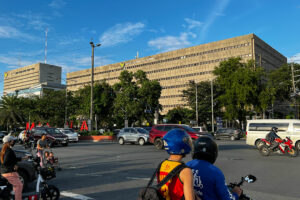BSP unlikely to cut rates soon as inflation risks linger

THE BANGKO SENTRAL ng Pilipinas (BSP) is unlikely to start easing its policy stance anytime soon, with a robust economy giving it room to keep borrowing costs high amid lingering upside risks to inflation, analysts said.
The BSP will likely keep borrowing costs steady at its first rate-setting meeting of the year on Feb. 15 even as the consumer price index (CPI) eased to an over three-year low in January, HSBC economist for ASEAN (Association of Southeast Asian Nations) Aris D. Dacanay said in a note.
“We still do not expect the BSP to begin its much-awaited easing cycle during the Monetary Board meeting next week,” Mr. Dacanay said. “For one, we still expect headline CPI to accelerate in the coming months when unfavorable base effects kick in.”
Headline inflation slowed to 2.8% in January from 3.9% in December and 8.7% a year ago, the Philippine Statistics Authority reported on Tuesday. This was the slowest pace since the 2.3% in October 2020 and marked the second consecutive month that the CPI was within the BSP’s 2-4% target band.
The January CPI was also below the 3.1% median in a BusinessWorld poll last week and matched the low end of the BSP’s 2.8-3.6% forecast.
After hiking borrowing costs by 350 basis points (bps) in 2022, the Monetary Board tightened by another 100 bps throughout 2023, bringing the policy rate to 6.5%, the highest in 16 years.
Keeping benchmark rates steady for now may be prudent as there is still a possibility of inflation breaching the BSP’s 2-4% target in the second quarter, BPI Lead Economist Emilio S. Neri, Jr. likewise said in a statement.
“The latest GDP (gross domestic product) report has also shown that the economy remains resilient despite the aggressive rate hikes from the central bank, which means there is no urgent need to cut interest rates soon,” he said.
“Should inflation stabilize within the target range in the second half of the year, we expect the BSP to cut the policy rate by 75 bps from 6.5% to 5.75% this year,” Mr. Neri said.
The Philippine economy expanded by 5.6% in the fourth quarter, bringing full-year GDP growth to 5.6% in 2023. This was lower than 7.6% in 2022 and fell short of the government’s 6-7% target.
Mr. Dacanay said risks to the inflation outlook remain tilted to the upside as utility rates were recently raised and as rice prices are still high.
“There are also pending petitions to hike wages and jeepney fares, two policies that could stoke another inflation wave if enacted simultaneously,” he said.
In January, Manila Electric Co. raised the rate for a typical household by P0.6232 to P10.9001 per kilowatt-hour.
Metro Manila’s two main water concessionaires also began implementing higher rates in January. Manila Water Co. raised rates by P6.41 per cubic meter, while Maynilad Water Services, Inc. hiked by P7.87 per cubic meter.
Agricultural disruptions due to El Niño and an increase in oil prices due to the ongoing Middle East conflict continue to be significant threats to inflation, Mr. Neri added.
“However, a return to the target range of the BSP in the second half of the year remains likely, assuming oil prices hold steady,” he said.
Meanwhile, Pantheon Macroeconomics Chief Emerging Asia Economist Miguel Chanco said the Monetary Board may start easing its policy stance in May and deliver a total of 100 bps in cuts this year amid slowing core inflation.
Core inflation, which excludes volatile prices of food and fuel, eased to 3.8% in January from 4.4% in December. This was the first time that core inflation settled within the 2-4% target after 17 months and was the slowest print since 3.1% in June 2022.
“(Core inflation) marks a symbolic return to the BSP’s 2-4% target range that will be hard for even the hawkish Monetary Board to ignore,” Mr. Chanco said.
The BSP sees headline inflation averaging 3.7% this year, slower than the 6% print in 2023, and easing further to 3.2% in 2025.
Meanwhile, the central bank’s risk-adjusted forecasts show that inflation could settle at 4.2% this year, above the 2-4% target, and could slow to 3.4% in 2025.
FED EASING AWAITEDThe BSP is also expected to follow the US Federal Reserve’s policy moves to support the peso and keep a healthy rate differential with the US, the analysts said.
“Our baseline is for the Fed to begin its easing cycle in June 2024 and for the Fed to cut rates by 25 bps in each quarter thereafter. But with growth in the Philippines strong, the BSP has room to cut much later than the Fed in the scenario of upside risks to inflation materializing all at the same time,” Mr. Dacanay said.
Mr. Neri likewise said the timing and size of future rate cuts from the BSP would depend on the Fed.
“If local inflation conditions are right, the BSP will likely respond immediately with rate cuts once the Fed begins its easing cycle,” he said.
“It seems the peso has the tendency to strengthen when the Fed eases its monetary policy. However, while a Fed cut might lead to peso appreciation, its gains are likely to be smaller compared to other emerging market currencies given the substantial current account deficit of the country,” Mr. Neri added.
The Fed kept its target rate steady at the 5.25-5.5% range for the fourth straight meeting last week. It hiked borrowing costs by 525 bps from March 2022 to July 2023. — Keisha B. Ta-asan




